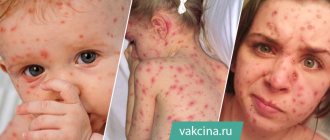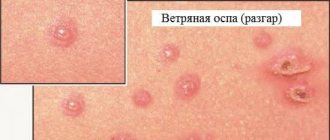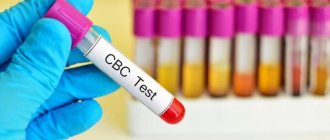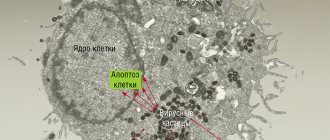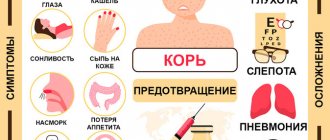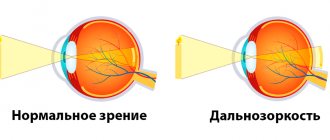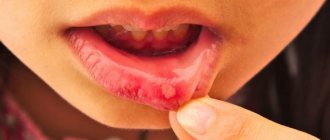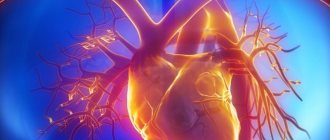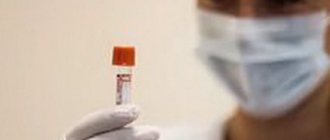How chickenpox begins in children - the first signs and symptoms in the initial stage (photo)
Chickenpox or varicella is an acute infectious disease caused by viruses of the herpes family. A distinctive feature of chickenpox is a rash on the skin in the form of small blisters. Almost all children aged 2 to 7 years old suffer from chickenpox, especially if they attend kindergarten, since the pathogenic virus is very volatile and can penetrate not only into adjacent rooms, but also into apartments.
In addition, a large percentage of the incidence of chickenpox in children is due to the fact that the latent period of the disease is 14-21 days, due to which the virus has time to spread and cover all children in the group or kindergarten. The chickenpox virus ceases to act until the last rash ends, that is, the virus stops being transmitted when the last blisters begin to heal.
How can you get infected?
The virus is transmitted from person to person by airborne droplets. Chickenpox penetrates through the mucous membranes of the mouth, respiratory tract, and eyes deep into the body.
The chickenpox virus is very persistent and spreads quickly. He has the ability to penetrate even into other rooms and neighboring apartments. This is why children in groups become infected with chickenpox so easily. Just one child in a group who becomes infected with chickenpox immediately becomes dangerous for the children of the entire institution.
First signs
How does chickenpox start in children? First of all, the child develops:
- high temperature (up to 39.5°C),
- feverish reaction;
- moderate intensity headache;
- pain in the abdominal area (not always);
- general malaise;
- signs of intoxication (possible nausea and vomiting);
The first signs of chickenpox in children, as a rule, are indistinguishable from “normal” ARVI. The main symptom of chickenpox is a characteristic rash (first small pink spots, and then blisters with clear liquid).
Diagnosis of chickenpox
The basis for detecting herpes is a virological study - examination of media to detect the pathogen. In case of chickenpox, for diagnosis, liquid from vesicles is used, in which, when stained, accumulations of the pathogen, the Argan corpuscle, are isolated.
Chickenpox is usually distinguished from insect bites. The main difference is the lack of development of elements and bedding, as well as normal body temperature.
Also, the disease should be differentiated from:
- streptoderma - occurs without fever, the rash is different - cloudy, purulent contents, after involution leaving a yellow crust, in its place a red spot forms. The rash is located mainly behind the ears and on the extremities, never on the scalp (a hallmark of chickenpox).
- herpes zoster - the blisters are located strictly along the nerve trunk; they practically never occur on the legs and arms.
- vesicular rickettsiosis - a small scab forms at the site of the tick bite, followed by the formation of an ulcer (a scar forms in its place after healing). Enlargement of regional lymph nodes is typical.
Symptoms and signs of chickenpox in children
Basically, chickenpox is characterized by a typical, uniform course in all children, with rare exceptions, so the following main symptoms of this disease in the initial stage can be identified (see photo):
- Sudden onset of the disease with the development of intoxication and a sharp increase in temperature.
- Almost simultaneous appearance on the skin, sometimes on the mucous membranes, of typical vesicular elements.
- An undulating course of the disease process with periodic additions of papulovesicles.
- Increase in body temperature with each new wave of rash.
- The formation of crusts on the surface of the bubbles, which subsequently do not leave any scars after recovery.
All stages of chickenpox in children follow each other sequentially and are characterized by certain typical symptoms.
- The initial stage of chickenpox and the child is the incubation period, which covers the time from the penetration of varicella-zoster into the baby’s body until the immediate manifestation of the first clinical symptoms. Its duration is considered to be from a minimum of 5 to a maximum of 21 days, however, on average it can last about 2 weeks. At this time, varicella-zoster actively multiplies and also accumulates in the mucous membranes of the oropharynx and nasal cavity, and is then able to overcome all protective barriers and penetrate the blood. At this moment, the very first sign of chickenpox in children develops: the appearance of a rash on the body, accompanied by a high temperature.
- The stage accompanied by the symptoms described above is called the initial stage, but sometimes it is preceded by a so-called prodromal period, during which a rise in temperature, headaches, weakness, and lethargy are recorded. The temperature with chickenpox in children sometimes reaches 40°C and above.
- As a result of the penetration of the chickenpox virus into the skin, local swelling is formed and a period of rash occurs, which can last from just 2 days to 7 days or even more. It is characterized by the initial formation of a red spot, which quickly takes the form of a papule, then transforms into a vesicle, which subsequently becomes covered with a crust. Most often, the patient’s torso is first affected by the elements of the rash, then the arms, legs, and only after that they can be detected on the face and scalp. This process is also characterized by very disturbing itching, which causes serious discomfort. Along with the formation of a rash, an increase in lymph nodes is observed, as well as the manifestation of symptoms of intoxication of the body.
- The last stage of chickenpox in children is characterized by normalization of body temperature, falling off of crusts, and improvement of the patient’s well-being. At the site of the former pathological element, covered with a crust, brownish pigmentation remains at first, however, over time it disappears. The skin after chickenpox in children, in the absence of constant scratching of itchy elements, with careful treatment and prevention of infection, remains healthy and clean. The average duration from the moment the first signs appear until the skin is completely cleared of crusts is about 3 weeks.
Chickenpox occurs extremely rarely in infants under 6 months of age, since the child is protected by antibodies received from the mother. If the disease is registered in a child under one year old, it proceeds quite easily. The temperature with chickenpox in children of this age is usually low, the period of rash is short, and the intoxication syndrome is practically not expressed. However, this applies to children born to mothers who had chickenpox as children. Otherwise, chickenpox in children under one year of age lasts quite a long time and is severe.
Chickenpox symptoms
Chickenpox usually lasts about ten days. The main symptom of chickenpox is a typical rash. One to two days before the rash appears, the following nonspecific symptoms may occur:
- Fever
- Decreased appetite
- Headache
- Fatigue and general malaise
The chickenpox rash goes through three stages of development:
- Pink or red spots and bumps (papules), which appear in spurts, with each new wave of fever, 2-6 shocks per day, for 3-6 days.
- After a few hours, these papules turn into blisters filled with clear liquid (vesicles), they last for a day, after which they burst and the liquid flows out
- After the blisters burst, after a few hours weeping appears - in their place crusts form, which last from several days to several weeks until new tender skin forms under them, after which they fall off.
Severity
Depending on the characteristics of its course in children, chickenpox is divided into three forms:
| Mild degree | characterized by isolated rashes, absence of fever and poor health. Herpetic pimples appear in only 2–3 days. |
| Moderate | all the symptoms that traditionally occur with chickenpox in children are present. These include poor sleep, itchy skin, headaches, and a rise in temperature to high levels. Blisters form within 5–7 days. |
| Severe form | Due to high temperature (up to 40°C), the child experiences nausea and vomiting, headache, delirium, and fever. Papules appear on the body from 7 to 10 days. Multiple rashes cover different areas of the body. It can be found in the mouth and on the genitals. |
Types and forms of the disease
In children, chickenpox occurs in a typical and atypical form; based on the symptoms, there are mild or latent, moderate and severe forms of the pathology.
Forms of the disease:
- mild – temperature values are normal or no more than 38 degrees, the period of rashes lasts no more than 4 days, the rashes are few in number, the general condition is satisfactory;
- moderate - intoxication is characterized by headache, aching in the lower back, muscles, fatigue, temperature readings above 38 °, numerous rashes appear over 5 days;
- severe - frequent vomiting, lack of appetite, temperature rises to 40 degrees, the period of rash lasts 9 days, the rash covers the entire body and mucous membranes.
Chickenpox is congenital - the child becomes infected in utero from the mother. If infection occurs in the early stages, children are born with various anomalies or deformities; if a woman is diagnosed with chickenpox in the later stages, the baby will be born with antibodies to chickenpox, without signs of pathology.
Chickenpox of newborns - develops if a woman becomes infected with the Zoster virus 5 days before giving birth, or within a few days after the birth of the child. The baby is born with typical signs of chickenpox; the pathology is easily treated with antiherpes drugs. But if therapy is not started in a timely manner, the mortality rate is more than 30%.
Turkish chickenpox got its name because its symptoms are similar to ordinary chickenpox, but the disease is caused by the Coxsackie enterovirus. The pathology manifests itself in the form of high fever, abscesses and ulcers in the mouth, on the buttocks, limbs, genitals, vomiting and intestinal upset. The incubation period is 3–10 days, immunity is not developed after recovery.
Sometimes children are diagnosed with false chickenpox - this is when an allergy occurs like chickenpox.
Types of atypical chickenpox
Gangrenous - the virus affects the deep layers of the skin, the cells gradually die, and necrosis develops a few days after the first rash appears. A characteristic sign is a dark purple rim around the papules; ichor accumulates in the blisters.
When the blisters open, they are covered with a scab; under the crust there is an ulcer that does not heal well. Gangrenous chickenpox occurs against a background of high temperature, severe intoxication, and the virus affects the nervous system. This type occurs in weakened children with various types of immunodeficiency, and often ends in death.
Bullous chickenpox - instead of a small rash, large blisters with a flabby surface and pale yellow liquid inside appear on the skin. After opening the bullae, long-term non-healing ulcers and deep wounds with a fibrin bottom appear.
Generalized chickenpox - the virus affects all internal organs; without timely and correct treatment, there is a high probability of death of the child. The pathology is rare, most often it is diagnosed in children with severe defects in the immune system, during long-term treatment with steroid or antitumor drugs.
The hemorrhagic form of chickenpox - blood accumulates in the blisters, blood clotting worsens, which causes nasal and internal bleeding, and the gums bleed heavily. Dark red crusts form in place of the papules; after recovery, deep scars and scars remain on the skin. The disease develops in patients with disorders of the hematopoietic system.
The rudimentary form is the safest type of chickenpox; it often occurs in an erased form, without a rash or with minor rashes in the form of spots, the temperature remains within normal limits. Diagnosed in infants in the first months of life, or in vaccinated children.
Important! After recovery, children develop stable, but not lifelong, immunity, so secondary chickenpox is often diagnosed in adolescence or adulthood.
Chickenpox in infants
It must be remembered that any child over the age of six months can get chickenpox. In most cases, the course of the disease in infants is quite complex: such young children do not tolerate symptoms well, cannot complain and cannot take advice. As a result, they need more careful care and constant attention from the mother.
Chickenpox in newborns is characterized by the same symptoms, but in young children, chickenpox, which occurs in a particularly complex form, can cause serious harm to the body, affecting the development of internal organs. Treatment of chickenpox in infants should be carried out under the strict supervision of a qualified pediatrician.
You should try to ensure that the child does not tear off the scabs from drying out rashes, because This will only make it more itchy and increase the risk of re-infection. The child's hands need to be washed more often, since the causative virus may be present on the skin and under the nails. Nails should be cut short. It is recommended that your baby wear cotton gloves at night.
Types of chickenpox (classification of chickenpox).
Chicken pox occurs in typical and atypical forms and in terms of severity is mild, moderate and severe. Chickenpox is also classified according to ICD-10 (with meningitis, encephalitis, pneumonia).
Atypical forms of chickenpox are divided into:
- Hemorrhagic form - a common consequence of this form is bleeding, and this form occurs in people with thrombocytopenia.
- Pustular form - develops when a bacterial agent is attached.
- Gangrenous form - can lead to the development of sepsis and occurs most often in patients with weakened immunity.
- The generalized (visceral) form of chickenpox is characterized by development in patients with immunodeficiency. It is very difficult, the symptoms are more pronounced and often ends in death for the sick person.
- The rudimentary form is found in children who received immunoglobulin during the incubation period. It flows quite easily.
The severity of chickenpox is directly determined by the degree of intoxication syndrome and its criteria, as well as the presence of specific vesicular rashes on the skin and mucous membranes. It should be noted that there are also so-called abortive (very mild) cases of the disease, which occur without the appearance of fever and are characterized by the appearance of single rashes on the skin of the abdomen and back. Such chickenpox is detected in kindergarten during examinations during outbreaks.
To the question “how long does chickenpox last?” It is difficult to answer unequivocally, since the duration of the disease directly depends on the form and course of chickenpox. On average, in the classical (typical) course, the duration of the disease is from 12 to 16 days.
How to treat chickenpox in a child?
Since chickenpox is caused by a virus, it is useless to treat the disease with antibiotics. The doctor may prescribe antibacterial drugs in cases where the course of chickenpox is complicated by the addition of a secondary bacterial infection.
There is no specific treatment against this infection, but necessary measures aimed at alleviating the patient’s condition must be taken. If a child gets chickenpox, the parents' task will be to minimize unpleasant symptoms and alleviate the baby's condition. To do this, at home, you must fulfill the basic conditions necessary for a speedy recovery:
- Observance of strict bed rest;
- Frequent change of underwear and bed linen;
- Increased drinking regimen to reduce intoxication;
- Light dairy-vegetable diet.
At the first unfavorable symptoms, you should call a doctor at home, who will give the necessary advice on care and prescribe medications to alleviate the child’s condition. The most important point of treatment during the active phase is the elimination of severe itching. When a rash appears, the skin itches and itches, and parents need to ensure that the baby does not scratch the itchy areas. This will help avoid the addition of a secondary bacterial infection.
- Blisters on the body should be treated several times a day with antiseptic solutions (green or colorless Castellani liquid). This will help prevent the infection from spreading further throughout the body and reduce the number of rashes. This treatment helps dry out the blisters and form a crust, speeding up recovery.
- To eliminate itching, the doctor may prescribe antihistamines (Suprastin, Diazolin, Diphenhydramine). These drugs effectively eliminate itching and have a mild calming and sedative effect, which will help cope with sleep disorders. The attending physician will select the required dose and dosage regimen.
- If a child has a high temperature, the doctor will prescribe antipyretics (Paracetamol, Nurofen, Efferalgan). It is not advisable to give aspirin to children under 10 years of age.
Drinking plenty of fluids (lemon tea, compotes, juices, green and herbal tea) will help you recover quickly; the liquid will remove toxins from the body. During illness, the child loses his appetite, but it is necessary to maintain his strength. A dairy-vegetable diet will help with this, providing the body with the necessary vitamins and nutrients.
Severe forms of chickenpox affecting internal organs are treated in a hospital. Complex therapy necessarily includes antiherpetic drugs (Zovirx, Acyclovir); immunoglobulin and interferon are used to treat the condition.
When to see a doctor?
If you suspect that you or your child has chickenpox, consult your doctor. The doctor will be able to make a diagnosis simply by examining you, studying the elements of the rash and accompanying symptoms. Your doctor may also prescribe medications to reduce the severity of chickenpox and reduce the risk of complications, if necessary. Call the pediatrician in advance and warn that you suspect chickenpox - the doctor will see you in a separate room, without waiting in line, to avoid the risk of infecting other patients.
Also, be sure to tell your doctor if you have any of these complications:
- The rash has spread to one or both eyes.
- The skin around some parts of the rash becomes very red, hot, or painful, indicating a secondary bacterial skin infection.
- The rash is accompanied by dizziness, disorientation, rapid heartbeat, shortness of breath, tremors (shaking hands), loss of muscle coordination, increasing cough, vomiting, difficulty bending the head forward, or a fever above 39.4 C.
- a history of any immunodeficiency, or age younger than 6 months.
Folk remedies
There are various ways to get rid of itching due to chickenpox and in traditional medicine:
- At high temperatures, it is advisable to drink cranberry juice, viburnum drink, rosehip infusion, and sea buckthorn tea. Strawberry juice saturates the body well with nutrients and has a pronounced antimicrobial effect.
- Bath with chamomile. 5 tbsp. Pour a tablespoon of inflorescences (dry or fresh) into a liter of hot water, bring to a boil and simmer over low heat for a quarter of an hour, strain. Add the decoction to the filled bath. The procedure takes 10 minutes, perform twice a day.
- Tea tree oil. The only essential oil allowed for direct application to the skin, without conductive oil. If you treat all elements of the rash with tea tree oil using a cotton swab, this will significantly relieve itching and scabies. This procedure promotes disinfection and speedy healing of wounds.
- Mix equally chamomile flowers, coltsfoot grass, chicory grass, calendula flowers, burdock root and immortelle flowers. Brew the prepared mixture with a dose of 40 g with half a liter of boiling water. Let it brew in a thermos for 8 hours. Take 4 times a day, a third of a glass.
- Grind the calendula herb. Heat 60 g of calendula, previously brewed in a liter of water. Pour the strained broth into the bath and bathe the patient for a quarter of an hour in the morning and evening. Do not rub the skin.
How many days does quarantine last for chickenpox?
Doctors have given an opinion on the contagiousness of the disease: from 4 to 13 days. Therefore, epidemiologists, if it is necessary to announce quarantine measures, close educational institutions for 14 days. During this period, the child cannot be allowed into kindergarten or school.
The first 5-10 days are dangerous for others during this period. You can focus on the appearance of the rash - while it is present on the body, the virus is in active form. During this period, it is very important to limit the patient’s contact with healthy people.
Is it possible to swim if you have chickenpox?
Contrary to popular misconceptions, you can and should swim when you have chicken rash. The main thing is to take a warm bath; the water should not be hot or cold. The baby should also walk in the fresh air, but avoid contact with other children. In such conditions, treatment will be more effective, and the patient will be able to avoid complications and other severe consequences of chickenpox.
How many days does a child have fever with chickenpox?
Very often, the temperature for this disease rises during the prodromal period - when preliminary symptoms appear. The increase in temperature may not be very critical - up to about 38 degrees, sometimes with a feeling of nausea and even vomiting.
The temperature may rise and fall slightly throughout the course of the disease - with each new rash on the baby's skin. During such periods, it is necessary for the baby to drink enough fluids, rest and get a good night's sleep. It is not recommended to reduce the temperature with antipyretic drugs if it has not reached high values.
It is strictly forbidden to give aspirin to your child. However, timely prevention will help avoid complications, and even infection with chickenpox itself. The main thing is to do everything in a timely manner and completely isolate the baby from contact with patients.
Chickenpox and pregnancy
A special type of complications from chickenpox can occur in pregnant women. Chickenpox in early pregnancy can lead to a variety of problems in the newborn, including low birth weight and birth defects such as limb abnormalities. A particularly great threat to the child occurs when the mother gets chickenpox a week before giving birth. In this situation, there is a high risk of infection that is life-threatening to the newborn (congenital chickenpox syndrome).
If you are pregnant and have been in contact with someone who has chickenpox, be sure to talk to your doctor about the risks to you and your unborn baby.
Advice from Doctor Komarovsky
The most common question that concerned parents ask their favorite doctor concerns the effects of brilliant green in children with chickenpox. Evgeniy Komarovsky’s answer is unequivocal - there is no therapeutic effect from such an action, brilliant green serves only as an indicator of the period of contagiousness. Lubricating the blisters with a colored solution every day, one day mommy notices that there are no new rashes. From this moment the countdown begins for the last five days, when the baby can pose a danger to others.
The doctor draws the attention of parents to the fact that the viral infection, which is chickenpox in children, is not susceptible to antibiotics and does not require special medications during the normal course of the disease. Only in adolescence, when the disease is too severe, do doctors prescribe antiherpetic drugs.
The main advice that Dr. Komarovsky gives for mothers of sick children:
- avoid overheating, which increases itching;
- cut your nails short, wear gloves if necessary, and do your best to distract the baby from combing the bubbles;
- do not give aspirin so as not to cause liver complications;
- scratching the blisters leads to bacterial infection and the likelihood of marks for life;
- chickenpox quite strongly suppresses the immune system, so after suffering from the disease you should refrain from visiting kindergarten and devote more time to walks.
Regarding vaccinations, Komarovsky believes, sensible parents should not have any discussions. However, he reminds that vaccination against chickenpox is voluntary, so mothers and fathers will have to take responsibility for its implementation.
Possible complications
Fortunately, most children recover well from chickenpox. However, in some categories of patients the disease may have unfavorable outcomes, such as:
- Hepatitis;
- Pathology of the structures of the eyeball (keratitis);
- Encephalitis. This pathology is manifested by severe damage to the central nervous system, manifested by seizures. This is due to the high tropism of the virus to nervous tissue. In most cases, this complication is detected in patients on days 7-12 of the disease. A persistent disorder of higher nervous activity in the form of idiocy occurs relatively rarely;
- Pustular skin lesions: phlegmon, abscesses or boils. They are the result of penetration of pathological microorganisms into the liquid inside the vesicle, which, upon contact with neutrophils, can form pus;
- Pneumonia. Most often diagnosed in adults. A feature of chickenpox pneumonia is the extreme paucity of clinical symptoms. The diagnosis can only be made by x-ray, and the image reveals small inflammatory foci throughout almost the entire length of the lung tissue;
- Myocarditis is inflammation of the heart muscle. It is manifested by dullness of heart sounds, pain in the heart area, as well as changes in the cardiogram;
- Nephritis is an inflammatory kidney disease that most often occurs on the 10th-12th day of illness. In most cases, this pathology goes away on its own and does not require any specific therapy.
However, chickenpox can still serve as a reason for the appearance of another disease, not as a complication. As you already know, chickenpox is a type of herpes virus, therefore the virus remaining in the body is inactive and occurs in a latent state. However, as a result of repeated exposure to the chickenpox virus and a number of associated factors, it can lead to the occurrence of a disease such as herpes zoster.
Chickenpox - definition
Chickenpox (also known as varicella) is an infectious disease of Chickenpox (Varicella).
It is caused by the varicella zoster virus. By the way, a close relative of the herpes familiar to many. All herpes are contagious, but varicella is the coolest. Chickenpox spreads through airborne droplets, and does so very actively. To catch an infection, sometimes it’s enough to look into the patient’s room for a second.
It always seemed to people that the disease was literally carried through the air, by the wind. Hence the first part of the name - wind. It was named smallpox because of the numerous rashes in the form of fluid-filled vesicles (papules), similar to those that form in smallpox.
Fortunately, chickenpox is not as deadly.
Is it worth getting vaccinated?
Doctors began vaccinating children against chickenpox relatively recently. The composition of the vaccine is represented by live but weakened pathogens. The first vaccination is usually given at 12–14 months. The chickenpox vaccine is re-administered after 3 to 5 years. Adolescents and adults who do not have natural immunity are vaccinated twice, with an interval of 1 month or more between injections.
Young children tolerate chickenpox vaccinations well, and pediatricians do not record any adverse reactions. However, if the child is part of a group of frequently ill children, it is necessary to consult with the local pediatrician about the advisability of vaccination. A weakened body may react to vaccination with unpredictable phenomena.
Prevention
{banner_banstat9}
It is almost impossible for a child to avoid infection with chickenpox, since he is constantly in contact with other people. The main method of prevention is strengthening the body’s protective functions and observing hygiene rules.
Important! Vaccination against chickenpox is not included in the list of mandatory vaccines for children; parents can vaccinate with Okavax and Varilrix for a fee - the average cost of the procedure is 2.5–4.5 thousand rubles.
